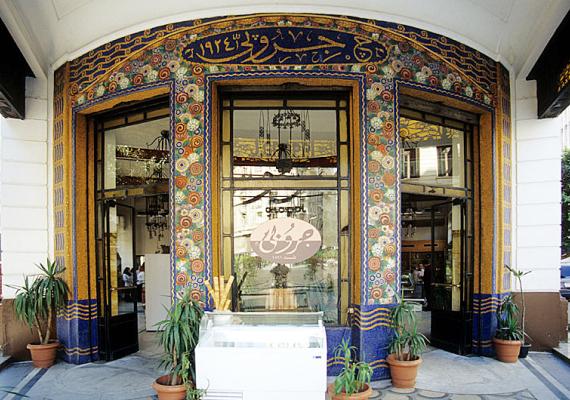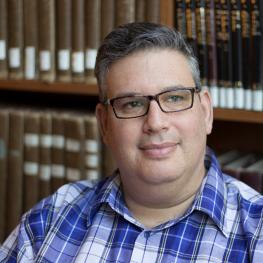Katz Center Fellow Alon Tam on Egyptian Jewish Culture

This blog post is part of a series focused on the research of current fellows. In this edition, Katz Center Director Steven Weitzman sits down with Alon Tam, who recently earned his PhD at Penn with a dissertation on coffeehouse culture in nineteenth- and early twentieth-century Egypt, and has wide-ranging interests in the modern Middle East. He is also currently an Israel Institute Visiting Faculty Member at Penn.
Steven P. Weitzman (SPW): Alon, can you tell us a bit about what led you to your scholarly interests?
Alon Tam (AT): My father’s family is Jewish-Egyptian, and I grew up with that strong heritage: Egyptian music, films, and family stories about life in Cairo filled my childhood. That was enough to get me interested in Middle East history and culture, as well as in Arabic literature and language, first in high school, and then throughout my academic career. My studies, however, did not start with Egypt, or its Jews: originally, I assumed that good scholars do not research anything remotely close to their personal background, in order to keep their objectivity and “impartial distance.” So I embarked on a journey that included studying different countries such as Saudi Arabia and Algeria, different time periods such as the medieval and the modern ones, and different topics such as “Islamics” and the making of modern states. I am grateful for this journey that made for a wide and thorough education, but times have changed, and nowadays one can affirm and even celebrate a strong personal connection to one’s field of research. So I have come full circle to study, first Egypt, and then its Jews. Today, I find myself contemplating whether, and how, to bring my own family history into my scholarly research and grappling with my own position as a scholar working on this subject.
The various intersections between the socio-political and the cultural, however, have remained a constant interest of mine. In addition, during my PhD studies at Penn, I followed my private passion for city life—and for engaging in a bit of flânerie (going-about-town)—so for the first time I systematically learned about urbanism, as well as about historical anthropology. Choosing to write about Cairo’s coffeehouses, then, came naturally to me, since I could justify doing research about a leisure activity that I thoroughly enjoy: sitting around coffeehouses with friends, and engaging in “people watching”!
SPW: Your work focuses on Cairo coffeehouses? That is like studying Starbucks as a window into American culture. Why focus on the coffeehouse as a way to understand modern Egyptian culture?
AT: Cairo was one of the first cities in the world where coffeehouses emerged at the turn of the sixteenth century, and they quickly became a social and cultural institution. It would be hard to exaggerate their importance: this was where men regularly met to socialize, network, and bond over coffee, the water-pipe, and a few board games; where performances of story-tellers, popular bards, singers, dancers, and shadow-puppeteers were held, later to be replaced by the gramophone, then the radio, and finally television and internet. This was where news of friends, family, neighborhood, and beyond circulated; where new immigrants, whether from the countryside or abroad, could find support systems that helped them navigate and settle in the new, often stress-inducing, megalopolis. Norms of gendering public spaces were shaped in and around coffeehouses, too.
In the late nineteenth century, new kinds of coffeehouses appeared in Cairo, brought by Mediterranean and European immigrants. These new coffeehouses attracted government bureaucrats and members of the Egyptian elite, as well as, most significantly, members of a new, emerging, urban middle-class, who were actively adopting and adapting styles they deemed to be modern and often European. The new coffeehouses innovated in their architectural designs, drinks and foodways, in their leisure activities, in the ways they were gendered, and in new social activities, especially reading newspapers and debating current affairs. They were used by that new middle class to network and form itself, as well as to perform its social identity and status. As this class became more involved in popular politics, so did coffeehouses become hubs for their activity. In short, Cairo’s coffeehouses were multifunctional and multivalent spaces that hosted major cultural, social, even political events and historical processes. They were the kind of spaces about which the geographer Edward Soja theorized (drawing on the ideas of the philosophers Foucault and Lefebvre). In that sense, I would actually compare Cairo’s coffeehouses to American pubs and bars rather than Starbucks: they were spaces where people lingered and socialized, not where they worked and drank coffee alone.
SPW: How do Jews fit into this story?
AT: Jews were part and parcel of that scene. They frequented coffeehouses, and some owned coffeehouses (and bars). They socialized with their friends—Jews and non-Jews—in those coffeehouses, networked, and even courted. They read the newspapers there, together with their colleagues, and discussed current affairs; the activists among them also hatched their plans there.
However, I was hard pressed to find distinctly “Jewish coffeehouses” of the kind that Shachar Pinsker writes about in his latest book, A Rich Brew: How Cafés Created Modern Jewish Culture (NYU Press, 2018), in which he deals with Eastern and Central Europe, New York City, and Tel Aviv. This gives me pause to think about what constitutes a “Jewish space” anyway. Egyptian Jews, especially of the emerging middle-class, were keen on blending into non-Jewish society. In fact, the dozen or so Jewish octogenarians whom I interviewed for this research, who remember Cairo in the 1940s, emphasized the fact that they socialized with their Muslim and Christian friends in coffeehouses, and their Jewishness “did not matter.” This was no accident: it was a purposeful act of joining and belonging to that urban middle-class. It encourages me to think about Jewishness not as a fixed, monolithic identity, but as a dynamic one, that changes across social spaces, settings, and times. Where and when did one’s Jewishness matter more, or less? And did it matter differently to different social classes in the Jewish community? And how about gender? For example, a Jewish middle-class man in Cairo could be “not-so-much-Jewish” on, say, Monday, when he met his Muslim and Christian friends in their regular coffeehouse, and continue to be “not-so-much-Jewish” on Tuesday when he met others at a “general” clubhouse; but his Jewishness certainly mattered on Wednesday, when he met his all-Jewish friends in an exclusively Jewish clubhouse like B’nei B’rit; and it would have been on full display at the synagogue on Shabbat. These dynamics and itineraries of Jewish identity across spaces, times, and social classes are the subject of my current work on the Jewish community in Egypt.
SPW: Among the many reasons your research is so interesting is that it gives us a chance to eavesdrop on some really interesting conversations that we were probably not meant to hear. Can you give us an example of something interesting you’ve learned by eavesdropping on these conversations?
AT: The main way that I, as a historian, have been able to “eavesdrop” on coffeehouse conversations has been by reading early twentieth-century surveillance reports written by spies and informants who worked for the state to monitor conversations that had a bearing on public order and the government’s standing. Of course, people in coffeehouses talked about so much more than that, but at the same time, coffeehouses were hubs for political talk and action since their very emergence in the sixteenth century, and they had an important role in shaping public opinion, discourse, and even popular politics. Egyptian surveillance reports from the turn of the twentieth century detailed coffeehouse conversations about the ruler, the government, and major political events; recorded antigovernment journalists who wrote their damning articles in coffeehouses; traced how rumors circulated between coffeehouses and other places in the city, such as private salons of important people, or clubhouses; and described the sexual escapades and drunken behavior of high-ranking army officers and government officials that took place in coffeehouses and bars, and that could have potentially harmed the standing of the state in public.
Jews occasionally appear in such reports, as in the time (recorded in a report from 1901) when a Sufi leader tried to trade “the [secret] knowledge” of Rabbi Bahur Levi, “the famous astrologer” from Izmir, in a coffeehouse called “Islambul”; or when a “morally deprived” police officer allegedly took a liking to young Jewish boys, and got into a fist fight (recorded in a report from 1896) with the father of one of those boys in front of a coffeehouse called “Gregory.”
For the Egyptian middle class, coffeehouses were also a place to read the newspapers and discuss current affairs, making sense of the fast-changing reality around them. As this middle class became increasingly involved in nationalist, anti-British activity, coffeehouses became major hubs, culminating in their pivotal role in organizing the year-long protests known as the 1919 Revolution. British surveillance reports recorded such activity on a daily basis. The curious thing about the relationship between state surveillance and the public is that the denizens of Cairo’s coffeehouses were well aware of that surveillance, which was only semi-covert, but at least until the 1950s, continued their political activity there more or less unabated.
SPW: A few weeks ago, Katz fellows met with the leader of Cairo’s present-day Jewish community, a community comprised of just three people! The person we met, Magda Haroun, may well be the last member of a great Jewish community whose history goes back to the medieval period if not earlier. What were you thinking when we met her?
AT: For me, and I am sure for others as well, this must have been one of the most unique and important events at the Katz Center this year, and maybe in many years. Besides her official role in Egypt, it was a rare opportunity for the Katz Center fellows, who during this fellowship year work on the Jewish communities in the Islamic world, to meet a member of such a community, when most of them are all but gone, albeit in different circumstances, certainly different from the fate of European Jewry. Moreover, for me personally, as someone who has followed the career and activity of Magda Haroun for a long time, it was a treat to meet her in the flesh. She presented her great efforts to preserve the Jewish heritage in Egypt, efforts that continue the work of her predecessors in that role, and are joined by the long-time endeavors in this regard of the Jewish-Egyptian diaspora around the world. I wondered about the weight of responsibility that she must feel knowing that she is near the end of this thousands-years-long history, a realization that constitutes the impetus for her plan of action. What can and will this history, with its tangible traces of material culture, mean, both for non-Jewish Egyptians, and for Jews around the world? I must admit that I was quite moved when she intimated at the end of the meeting that all she is working for now is for “us to be remembered.”
